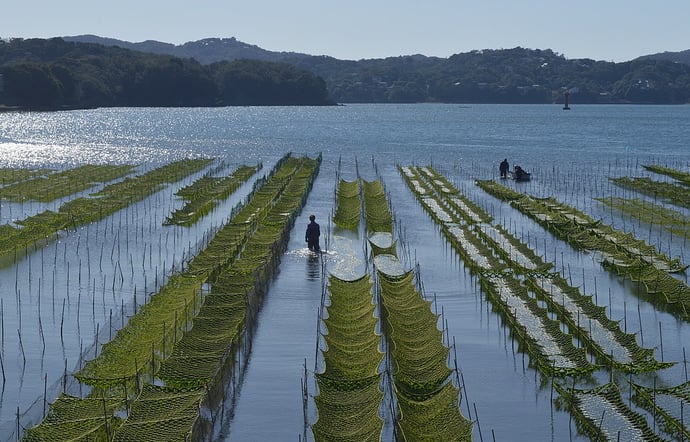40+
methane reduction by cattle through feeding red algae*
algae farms in the EU
Algae farming (also called seaweed cultivation) is the process of growing seaweed in controlled environments — often underwater. Farmers use either ropes or nets, where the algae can grow onto.
Why do people even farm algae? Because it is a super-resource that can be used for food, supplements, biofuels, textiles and more.
But setting up a place to grow algae isn´t always easy. It requires:
many heavy-weight anchors
or anchoring lines in coastal areasensuring algae get the right conditions to grow
maximizing space to achieve the best yield
what is algae farming?
example of a NORI seaweed farm in Japan
photo by Asturio Cantabrio - Own work, CC BY-SA 4.0
Currently, there are very few alternatives to the line or net cultivation method for algae farming, as switching to more environmentally friendly and degradable materials proves challenging under sea conditions and their susceptibility to weather conditions.
Nonetheless, at cerberus, we parallely continue to test alternative ways to grow algae in the water, with as much recyclable materials we can manage. We are not a farm but algae cultivation enthusiasts! It´s not quick work, as the sea is unforgiving and we depend on our partners for rare testing areas. But next to evaluating our seaweed systems, we are always happy for new partners to join the seaweed journey.
another example of a seaweed farm using vertical
lines with weights
illustration © cerberus innovation UG
explore
new ways!
Our EU-patented design of the cultivation cages is simple yet effective!
Just take our round cages, wind up your line with baby algae onto the cage and hang it into the water for continue growing. On a line, an existing infrastructure or individually. Traditional algae farming can be tricky for starters or smaller areas — anchoring lines, maximizing space, and handling rough waters. cerberus seaweed system and its compact & modular design makes it easy to start small, expand, and cultivate multiple species at the same spot efficiently.
our compact




Option A: Installation on line
Option B: Individual anchoring










